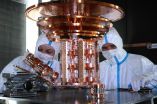The study was conducted during the staged implementation of computerized physician order entry when integrated into electronic health records across 16 Kaiser Permanente Northern California medical centers from 2007 to 2012. After implementation, emergency department stroke guidelines were made available to physicians using an electronic template, known as an "order set." Order sets are designed to provide standardized laboratory, radiographic and drug ordering, as well as information to help guide doctors in making clinical decisions.
"This study demonstrates that computerized physician order entry generally -- and an order set embedded with decision support specifically -- can facilitate the delivery of time-sensitive interventions for stroke while minimizing errors," said lead author Dustin Ballard, MD, an emergency medicine physician at the Kaiser Permanente San Rafael (California) Medical Center and an adjunct researcher at the Kaiser Permanente Division of Research. "In this case, the investigation showed that these tools can safely lead to more frequent administration of medication to thin blood and break up blood clots in the brain, a treatment that has been associated with better neurological recovery after stroke."
Stroke is a major cause of death and a leading cause of serious long-term disability in the United States. Ischemic stroke, the most common type, is caused by a clot obstructing the flow of blood and oxygen to the brain, which can result in the death of brain cells. Consequently, time is of the essence in assessment and emergency treatment.
"While the technology is not likely to be solely responsible for the improved outcomes observed in this study, it may represent a proxy measure for optimum care for certain patients, in particular those for whom the speed of initiating therapy, the completeness of information available to the clinician, and the intensity of inpatient care make a real difference in short-term outcomes," added co-author David Vinson, MD, an emergency medicine physician at the Kaiser Permanente Roseville (California) Medical Center.
A systematic approach to the acute management of patients with ischemic stroke -- including the timely administration of intravenous tissue plasminogen activator (or IV tPA) for eligible patients -- can help avoid complications and improve outcomes. IV tPA helps to thin the blood and dissolve clots, with the goal of restoring blood flow through blocked arteries in the brain. Emergency department evaluation of patients with suspected stroke is focused on rapidly assessing eligibility for time-sensitive interventions such as IV tPA, which has been shown to improve neurological outcomes for acute ischemic stroke.
Of the 10,081 patients examined during the study period, 6,686 (66.3 percent) were treated in medical centers after computerized physician order entry had been implemented. IV tPA was administered in the emergency department to 8.9 percent of these patients, compared to 3.3 percent of patients in emergency departments at medical centers without the new technology -- more than doubling the rate of IV tPA administration. When the stroke order set was employed in combination with the computerized physician order entry, IV tPA administration increased to 12.7 percent -- a nearly three-fold increase. Even after accounting for variable factors, these differences held steady.
Together, Drs. Ballard and Vinson are co-founders of the Clinical Research in Emergency Services and Treatments (CREST) Network, a group of emergency medicine physician-researchers affiliated with the Kaiser Permanente Division of Research.
"Ultimately, we see the order set itself as optimizing the confluence of two separate processes -- a robust computerized physician order entry that integrates care across many providers and locations while limiting errors of omission, combined with a quality initiative that has identified disease-specific best practices and guidelines," Dr. Ballard wrote. "We believe that our findings represent a dawning era of electronic health records, one that blends decision support and best practices."
INFORMATION:
Other authors of the study include emergency medicine physicians of the CREST Network at Kaiser Permanente medical centers: David K. Park, MD, MPH, and Mamata V. Kene MD, MPH, San Leandro Medical Center, Uli K. Chettipally, MD, MPH, South San Francisco Medical Center, Dustin G. Mark, MD, Oakland Medical Center; Jie Huang, PhD, Hilary R. Iskin, BA, and Mary Reed, DrPH, Kaiser Permanente Division of Research; Anthony Kim, MD, MAS, Department of Neurology, University of California at San Francisco; and John Hsu, MD, MBA, MSCE, Mongan Institute for Health Policy, Massachusetts General Hospital, Department of
Health Care Policy, Harvard Medical School.
About CREST
The Clinical Research in Emergency Services & Treatments (CREST) Network is a multi-center collaborative that encourages, enables and executes research in emergency medicine. Its goals are to support a cooperative platform for the emergency medicine research community, encourage quality research in emergency medicine, and disseminate evidence-based knowledge to refine current community emergency care standards. CREST is headquartered at the Kaiser Permanente Division of Research, and its researchers currently represent the emergency departments of 10 Kaiser Permanente Northern California medical centers. For more information, visit http://www.kpcrest.net.
About the Kaiser Permanente Division of Research
The Kaiser Permanente Division of Research conducts, publishes and disseminates epidemiologic and health services research to improve the health and medical care of Kaiser Permanente members and society at large. It seeks to understand the determinants of illness and well-being, and to improve the quality and cost-effectiveness of health care. Currently, DOR's 500-plus staff is working on more than 400 epidemiological and health services research projects. For more information, visit http://www.dor.kaiser.org or follow us @KPDOR.
About Kaiser Permanente
Kaiser Permanente is committed to helping shape the future of health care. We are recognized as one of America's leading health care providers and not-for-profit health plans. Founded in 1945, Kaiser Permanente has a mission to provide high-quality, affordable health care services and to improve the health of our members and the communities we serve. We currently serve more than 10 million members in eight states and the District of Columbia. Care for members and patients is focused on their total health and guided by their personal physicians, specialists and team of caregivers. Our expert and caring medical teams are empowered and supported by industry-leading technology advances and tools for health promotion, disease prevention, state-of-the-art care delivery and world-class chronic disease management. Kaiser Permanente is dedicated to care innovations, clinical research, health education and the support of community health. For more information, go to: kp.org/share.

